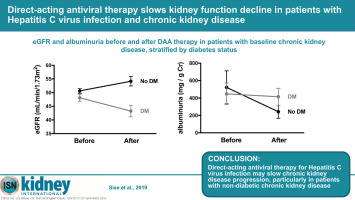当前位置:
X-MOL 学术
›
Kidney Int.
›
论文详情
Our official English website, www.x-mol.net, welcomes your
feedback! (Note: you will need to create a separate account there.)
Direct-acting antiviral therapy slows kidney function decline in patients with Hepatitis C virus infection and chronic kidney disease.
Kidney International ( IF 14.8 ) Pub Date : 2019-05-15 , DOI: 10.1016/j.kint.2019.04.030 Meghan E Sise 1 , Donald F Chute 2 , Yaa Oppong 1 , Maya I Davis 1 , Joshua D Long 1 , Sakuni T Silva 2 , Nifasha Rusibamayila 2 , Deborah Jean-Francois 2 , Syeda Raji 3 , Sophia Zhao 1 , Ravi Thadhani 4 , Raymond T Chung 2
Kidney International ( IF 14.8 ) Pub Date : 2019-05-15 , DOI: 10.1016/j.kint.2019.04.030 Meghan E Sise 1 , Donald F Chute 2 , Yaa Oppong 1 , Maya I Davis 1 , Joshua D Long 1 , Sakuni T Silva 2 , Nifasha Rusibamayila 2 , Deborah Jean-Francois 2 , Syeda Raji 3 , Sophia Zhao 1 , Ravi Thadhani 4 , Raymond T Chung 2
Affiliation

|
Hepatitis C virus (HCV) infection is common and can accelerate chronic kidney disease (CKD) progression. Direct-acting antiviral (DAA) therapies against hepatitis C have consistently shown rates of sustained viral remission. However, the effect on kidney function is unknown. In a retrospective observational cohort study of HCV-infected patients receiving DAA therapies from 2013 to 2017, the slopes of estimated glomerular filtration rate (eGFR) decline were compared in the three years before DAA therapy to the slope after therapy. Pre- and post-treatment albuminuria values were also compared. In all, 1,178 patients were included; mean age of 56, 64% male, 71% white, 21% were diabetic, and 42% with cirrhosis. In patients with eGFR less than 60ml/min per 1.73m2, the annual decline in eGFR in the three years prior to treatment was -5.98 ml/min per year (95% confidence interval -7.30 to -4.67) and improved to -1.32 ml/min per year (95% confidence interval -4.50 to 1.88) after DAA therapy. In patients with eGFR greater than 60ml/min per 1.73m2 the annual decline in eGFR in the three years prior to treatment was -1.43 ml/min per year (95% confidence interval -1.78 to -1.08) and after DAA therapy was -2.32 ml/min per year (95% confidence interval -3.36 to -1.03). Albuminuria improved significantly in patients without diabetes, but not in those with diabetes. Predictors of eGFR improvement included having CKD at baseline and being non-diabetic. Events of acute kidney injury were rare, occurring in 29 patients, and unrelated to antiviral therapy in 76% of cases. Thus, DAA therapy for HCVs infection may slow CKD progression.
中文翻译:

直接作用抗病毒治疗可减缓丙型肝炎病毒感染和慢性肾脏病患者的肾功能下降。
丙型肝炎病毒 (HCV) 感染很常见,可以加速慢性肾病 (CKD) 的进展。针对丙型肝炎的直接作用抗病毒(DAA)疗法始终显示出持续的病毒缓解率。然而,对肾功能的影响尚不清楚。在一项对 2013 年至 2017 年接受 DAA 治疗的 HCV 感染患者进行的回顾性观察队列研究中,将 DAA 治疗前三年的估计肾小球滤过率 (eGFR) 下降的斜率与治疗后的斜率进行了比较。还比较了治疗前和治疗后的蛋白尿值。总共包括 1,178 名患者;平均年龄 56 岁,64% 为男性,71% 为白人,21% 患有糖尿病,42% 患有肝硬化。 eGFR每1.73平方米低于60ml/min的患者,治疗前三年eGFR每年下降-5.98ml/min(95%置信区间-7.30至-4.67),改善至-1.32ml DAA 治疗后每年 / 分钟(95% 置信区间 -4.50 至 1.88)。在 eGFR 每 1.73m2 大于 60ml/min 的患者中,治疗前三年 eGFR 每年下降 -1.43 ml/min(95% 置信区间 -1.78 至 -1.08),DAA 治疗后为 -2.32每年毫升/分钟(95% 置信区间 -3.36 至 -1.03)。非糖尿病患者的蛋白尿显着改善,但糖尿病患者则没有显着改善。 eGFR 改善的预测因素包括基线时患有 CKD 和非糖尿病。急性肾损伤事件很少见,发生在 29 名患者中,并且 76% 的病例与抗病毒治疗无关。因此,针对 HCV 感染的 DAA 治疗可能会减缓 CKD 的进展。
更新日期:2019-11-20
中文翻译:

直接作用抗病毒治疗可减缓丙型肝炎病毒感染和慢性肾脏病患者的肾功能下降。
丙型肝炎病毒 (HCV) 感染很常见,可以加速慢性肾病 (CKD) 的进展。针对丙型肝炎的直接作用抗病毒(DAA)疗法始终显示出持续的病毒缓解率。然而,对肾功能的影响尚不清楚。在一项对 2013 年至 2017 年接受 DAA 治疗的 HCV 感染患者进行的回顾性观察队列研究中,将 DAA 治疗前三年的估计肾小球滤过率 (eGFR) 下降的斜率与治疗后的斜率进行了比较。还比较了治疗前和治疗后的蛋白尿值。总共包括 1,178 名患者;平均年龄 56 岁,64% 为男性,71% 为白人,21% 患有糖尿病,42% 患有肝硬化。 eGFR每1.73平方米低于60ml/min的患者,治疗前三年eGFR每年下降-5.98ml/min(95%置信区间-7.30至-4.67),改善至-1.32ml DAA 治疗后每年 / 分钟(95% 置信区间 -4.50 至 1.88)。在 eGFR 每 1.73m2 大于 60ml/min 的患者中,治疗前三年 eGFR 每年下降 -1.43 ml/min(95% 置信区间 -1.78 至 -1.08),DAA 治疗后为 -2.32每年毫升/分钟(95% 置信区间 -3.36 至 -1.03)。非糖尿病患者的蛋白尿显着改善,但糖尿病患者则没有显着改善。 eGFR 改善的预测因素包括基线时患有 CKD 和非糖尿病。急性肾损伤事件很少见,发生在 29 名患者中,并且 76% 的病例与抗病毒治疗无关。因此,针对 HCV 感染的 DAA 治疗可能会减缓 CKD 的进展。











































 京公网安备 11010802027423号
京公网安备 11010802027423号